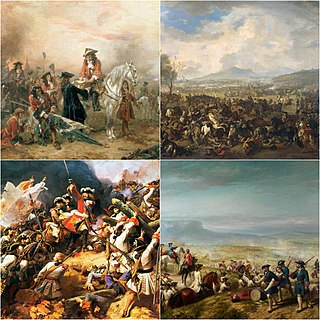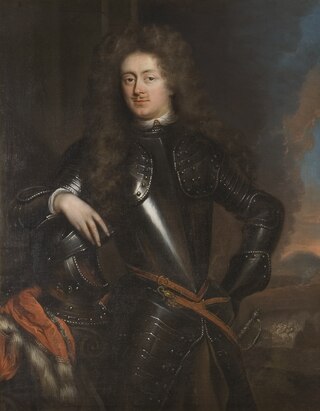
The War of the Spanish Succession was a European great power conflict fought between 1701 and 1714. The immediate cause was the death of the childless Charles II of Spain in November 1700, which led to a struggle for control of the Spanish Empire. His nominated heir was Philip of Anjou, a grandson of Louis XIV of France, whose main backers were France and most of Spain. His rival, Archduke Charles of Austria, was supported by the Grand Alliance, whose primary members included the Holy Roman Empire, the Dutch Republic, and Great Britain. Significant related conflicts include the 1700 to 1721 Great Northern War, and Queen Anne's War in North America.

The Battle of Oudenarde, also known as the Battle of Oudenaarde, was a major engagement of the War of the Spanish Succession, pitting a Grand Alliance force consisting of eighty thousand men under the command of the Duke of Marlborough and Prince Eugene of Savoy against a French force of eighty-five thousand men under the command of the Duc de Bourgogne and the Duc de Vendôme, the battle resulting in a great victory for the Grand Alliance. The battle was fought near the city of Oudenaarde, at the time part of the Spanish Netherlands, on 11 July 1708. With this victory, the Grand Alliance ensured the fall of various French territories, giving them a significant strategic and tactical advantage during this stage of the war. The battle was fought in the later years of the war, a conflict that had come about as a result of English, Dutch and Habsburg apprehension at the possibility of a Bourbon succeeding the deceased King of Spain, Charles II, and combining their two nations and empires into one.

Anthonie Heinsius was a Dutch statesman who served as Grand Pensionary of Holland from 1689 to his death in 1720. Heinsius was a tough negotiator and one of the greatest and most obstinate opponents of the expansionist policies of Louis XIV's France. He was one of the driving forces behind the anti-France coalitions of the Nine Years' War (1688–97) and the War of the Spanish Succession (1701–14).

The Barrier Treaties were a series of agreements signed and ratified between 1709 and 1715 that created a buffer zone between the Dutch Republic and France by allowing the Dutch to occupy a number of fortresses in the Southern Netherlands, ruled by the Spanish or the Austrians. The treaties were cancelled by Austria in 1781.

At the Battle of Elixheim, 18 July 1705, also known as the Passage of the Lines of Brabant during the War of the Spanish Succession, the Anglo-Dutch forces of the Grand Alliance, under the Duke of Marlborough, successfully broke through the French Lines of Brabant. These lines were an arc of defensive fieldworks stretching in a seventy-mile arc from Antwerp to Namur. Although the Allies were unable to bring about a decisive battle, the breaking and subsequent razing of the lines would prove critical to the Allied victory at Ramillies the next year.

The Battle of Ekeren, which took place on 30 June 1703, was a battle of the War of the Spanish Succession. A Bourbon army of around 24,000 men, conisting of troops from France, Spain and Cologne, surrounded a smaller Dutch force of 12,000 men, which however managed to break out and retire to safety.

The siege of Bouchain, was a siege of the War of the Spanish Succession, and a victory for the French troops of the Duc de Villars. A French army of 20,000 men besieged and captured the Allied-controlled fortifications after an 18-day siege, with the 2,000-strong Dutch-Imperial garrison under Major-General Frederik Sirtema van Grovestins capitulating on 19 October.

The siege of Zoutleeuw or the siege of Léau was a siege of the War of the Spanish Succession. Allied troops with 16 artillery pieces under the command of the English Captain general the Duke of Marlborough, besieged and captured the small French-held Brabantine fortified town of Zoutleeuw in the Spanish Netherlands.

The siege of Ghent was the last operation of the 1708 campaign season during the War of the Spanish Succession. After successfully taking Lille shortly before, the Duke of Marlborough moved his forces onto the town of Ghent where after a 12-day siege the town's governor, Count Charles de La Mothe-Houdancourt, surrendered.

The siege of Ostend took place during the War of the Spanish Succession. In the wake of the Allied victory over the French at the Battle of Ramillies in May 1706, town and cities across the Spanish Netherlands rapidly surrendered to the Duke of Marlborough's victorious forces often without a fight. Ostend, a port on the North Sea coast, offered more resistance.

Claude Frederic t'Serclaes, Count of Tilly, was a prominent Walloon general in service of the Dutch States Army. He took part in the Franco-Dutch War, Nine Years' War and the War of the Spanish Succession and proved a brave and capable cavalry general. In 1708 he became the de facto supreme commander of the Dutch army, and led the Allied forces together with the Duke of Marlborough and Eugene of Savoy.

The assault on Nijmegen occurred during the War of the Spanish Succession, on 10 and 11 June 1702 involving French troops under the Duc de Boufflers against the small garrison and some citizens of the city of Nijmegen and an Anglo-Dutch army under the Earl of Athlone.
The field deputies were the representatives of the various Dutch sovereign provinces in the armies of the Dutch Republic. They represented, usually in numbers of five or nine, the highest authority in the country within the Dutch States Army, and ensured that the orders of the Dutch States General were respected and above all that the privileges of the provinces and cities were respected, to which they were generally very zealous. The deputies were also charged with maintaining discipline of war, curbing all excesses and enforcing the military laws, conducting or ordering inspections of the troops, as well as ensuring the provisioning and supply of the troops. In rare cases, they also directly commanded troops in battle.

The Bombardment of Arras took place during the War of the Spanish Succession on 2 and 3 March 1712. An Allied army under Arnold van Keppel, Earl of Albemarle closed in on Arras with the aim of destroying the supplies held there. In this way, they hoped that the French would not be able to prevent the sieges of Arras and Cambrai. Although the action succeeded, the advantage had to go entirely unused because the Emperor's troops arrived too late to the Allied army.
Frederik Sirtema van Grovestins was a Frisian officer in the Dutch States Army. He advanced through the various ranks in the army, from captain and cavalry captain (Ritmeester) to lieutenant-general of cavalry. Furthermore, he became general-quarter-master of the army and colonel of a regiment on foot at the repartition of Zeeland. In 1712 he became governor of Bouchain, in 1718 of Bergen-op-Zoom. He was an outstanding cavalry commander who played an important role in various campaigns and battles. He also was an excellent military theorist, who stressed to the cavalry of the Allies to seek their strength in combat with the bladed weapon, something that possibly influenced Friedrich Wilhelm von Seydlitz when he developed the Prussian cavalry later in the 18th century.
Jacques-Louis, Comte de Noyelles was a Walloon military officer in the service of the Dutch Republic between 1672 and 1708. He was also named an Austrian Field Marshal. He served in the Franco-Dutch War, the Glorious Revolution, the Nine Years' War, and the War of the Spanish Succession in both the northern and the Iberian theatres of that war.

Frederick Christiaan van Reede, 2nd Earl of Athlone, baron of Ginkel and Agrim, lord of Amerongen, was a Dutch general and diplomat in the service of the Dutch Republic during the Nine Years' War and the War of the Spanish Succession.

Daniël Wolf baron van Dopff was a prominent soldier in the Dutch Republic. He was, among other things, general of the cavalry of the Dutch States Army in the War of the Spanish Succession, Quartermaster general of that army, and later commander and governor of the fortress of Maastricht.

The Battle of Stekene took place on 27 June 1703, during the War of the Spanish Succession, when a Dutch force of 7,000 men, under Karel Willem Sparre, attacked the Franco-Spanish defensive that ran from Ostend to Antwerp. The lines at Stekene were defended by 2,500 French soldiers under La Mothe and 1,500 to 6,000 local Flemish farmers. After a 3-hour long battle, the French abandoned their posts, which allowed the Dutch to capture the defensive works. The Dutch then attacked and captured the village of Stekene itself where the local farmers fiercely resisted.

Willem Karel, Baron of Sparre, was a Swedish soldier who served for most of his career in the Dutch States Army. In this capacity, he took part in the Nine Years' War and played a prominent role in the War of the Spanish Succession. He would die of an injury sustained during the bloody Battle of Malplaquet.


















